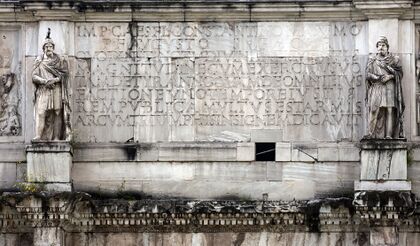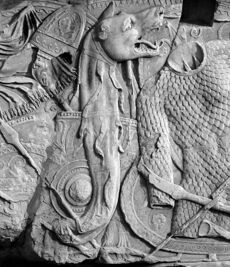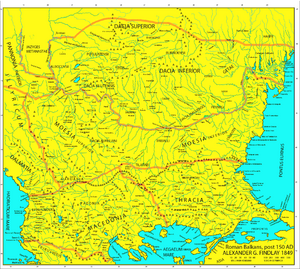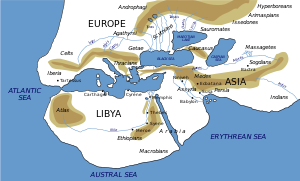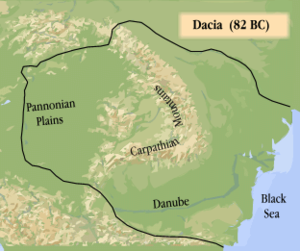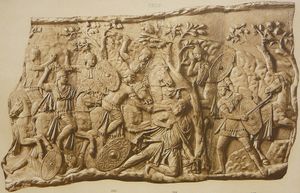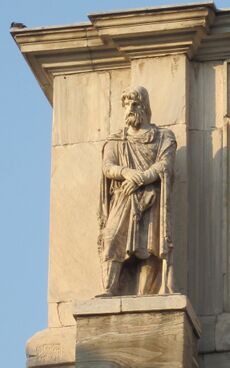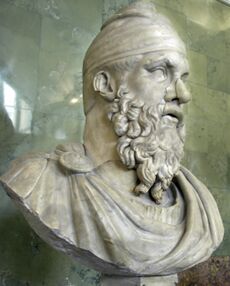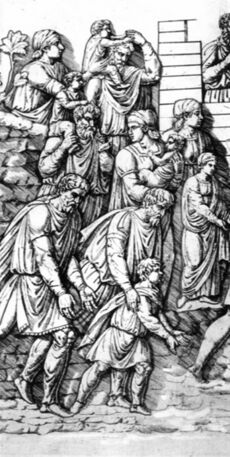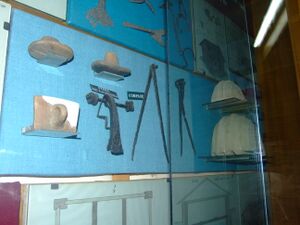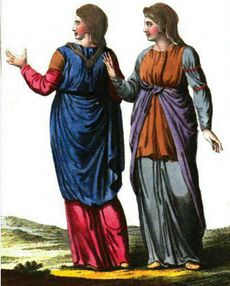داتشيون
الداتشيون (Dacians ؛ /ˈdeɪʃənz/؛ لاتينية: Daci [ˈd̪aːkiː]؛ باليونانية: Δάκοι,[2] Δάοι,[2] Δάκαι[3]) were the ancient Indo-European inhabitants of the cultural region of Dacia, located in the area near the Carpathian Mountains and west of the Black Sea. They are often considered a subgroup of the Thracians.[4] This area includes mainly the present-day countries of Romania and Moldova, as well as parts of Ukraine,[5] Eastern Serbia, شمال بلغاريا، سلوڤاكيا،[6] Hungary and Southern Poland.[5] The Dacians spoke the Dacian language, which has a debated relationships مع اللغة التراقية المجاورة وربما مجموعة فرعية منها. Dacians were somewhat culturally influenced by the neighbouring Scythians and by the الغزاة الكلت في القرن الرابع ق.م..
| هذا المقال هو جزء من سلسلة عن |
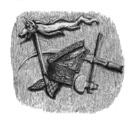 |
| داتشيا |
| الجغرافيا |
|---|
| الثقافة |
| التاريخ |
| داتشيا الرومانية |
| الذكرى |
. . . . . . . . . . . . . . . . . . . . . . . . . . . . . . . . . . . . . . . . . . . . . . . . . . . . . . . . . . . . . . . . . . . . . . . . . . . . . . . . . . . . . . . . . . . . . . . . . . . . . . . . . . . . . . . . . . . . . . . . . . . . . . . . . . . . . . . . . . . . . . . . . . . . . . . . . . . . . . . . . . . . . . . .
الاسم وأصله
الاسم
أصل الاسم
النظريات الأسطورية
الأصول وتكون الأعراق
الارتباط اللغوي
| جزء من سلسلة عن |
| المواضيع الهندو-أوروپية |
|---|
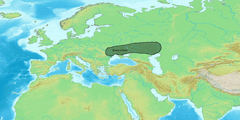 |
القبائل
. . . . . . . . . . . . . . . . . . . . . . . . . . . . . . . . . . . . . . . . . . . . . . . . . . . . . . . . . . . . . . . . . . . . . . . . . . . . . . . . . . . . . . . . . . . . . . . . . . . . . . . . . . . . . . . . . . . . . . . . . . . . . . . . . . . . . . . . . . . . . . . . . . . . . . . . . . . . . . . . . . . . . . . .
التاريخ
التاريخ المبكر
العلاقات مع التراقيين
العلاقات مع الكلت
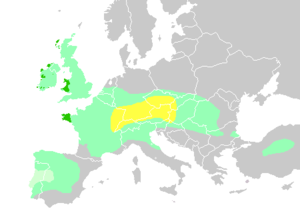

العلاقات مع اليونانيين
Greek and Roman chroniclers record the defeat and capture of the Macedonian general Lysimachus in the 3rd century BC by the Getae (Dacians) ruled by Dromihete, their military strategy, and the release of Lysimachus following a debate in the assembly of the Getae.
العلاقات مع الفرس
Herodotus says: "before Darius reached the Danube, the first people he subdued were the Getae, who believed that they never die".[7] It is possible that the Persian expedition and the subsequent occupation may have altered the way in which the Getae expressed the immortality belief. The influence of thirty years of Achaemenid presence may be detected in the emergence of an explicit iconography of the "Royal Hunt" that influenced Dacian and Thracian metalworkers, and of the practice of hawking by their upper class.[8]
العلاقات مع الاسكوذ
الممالك الداتشية
Dacian polities arose as confederacies that included the Getae, the Daci, the Buri, and the Carpi[محل شك] (cf. Bichir 1976, Shchukin 1989),[9] united only periodically by the leadership of Dacian kings such as Burebista and Decebal. This union was both military-political and ideological-religious[9] on ethnic basis. The following are some of the attested Dacian kingdoms:
The kingdom of Decebalus 87 – 106
النزاع مع روما
. . . . . . . . . . . . . . . . . . . . . . . . . . . . . . . . . . . . . . . . . . . . . . . . . . . . . . . . . . . . . . . . . . . . . . . . . . . . . . . . . . . . . . . . . . . . . . . . . . . . . . . . . . . . . . . . . . . . . . . . . . . . . . . . . . . . . . . . . . . . . . . . . . . . . . . . . . . . . . . . . . . . . . . .
الحكم الروماني
بعد انسحاب أورليان
المجتمع
Dacians were divided into two classes: the aristocracy (tarabostes) and the common people (comati). Only the aristocracy had the right to cover their heads, and wore a felt hat. The common people, who comprised the rank and file of the army, the peasants and artisans, might have been called capillati in Latin. Their appearance and clothing can be seen on Trajan's Column.
الاحتلالات
العملة
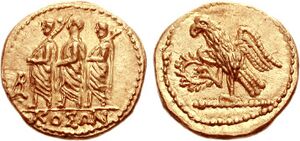
The first coins produced by the Geto-Dacians were imitations of silver coins of the Macedonian kings Philip II and Alexander the Great. Early in the 1st century BC, the Dacians replaced these with silver denarii of the Roman Republic, both official coins of Rome exported to Dacia, as well as locally made imitations of them. The Roman province Dacia is represented on the Roman sestertius coin as a woman seated on a rock, holding an aquila, a small child on her knee. The aquila holds ears of grain, and another small child is seated before her holding grapes.
الدين

الخزف
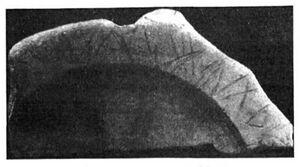
الملابس والعلوم
The typical dress of Dacians, both men and women, can be seen on Trajan's column.[12]
Dio Chrysostom described the Dacians as natural philosophers.[13]
في الوطنية الرومانية
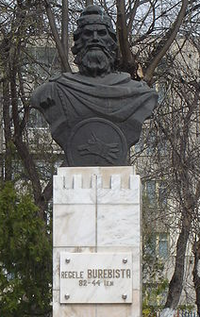
Study of the Dacians, their culture, society and religion is not purely a subject of ancient history, but has present day implications in the context of Romanian nationalism. Positions taken on the vexed question of the origin of the Romanians and to what degree are present-day Romanians descended from the Dacians might have contemporary political implications. For example, the government of Nicolae Ceaușescu claimed an uninterrupted continuity of a Dacian-Romanian state, from King Burebista to Ceaușescu himself.[14] The Ceaușescu government conspicuously commemorated the supposed 2,050th anniversary of the founding of the "unified and centralized" country that was to become Romania, on which occasion the historical film Burebista was produced.
انظر أيضاً
ملاحظات
المراجع
- ^ Westropp 2003, p. 104.
- ^ أ ب Strabo 20 AD, VII 3,12.
- ^ Dionysius Periegetes, Graece et Latine, Volume 1, Libraria Weidannia, 1828, p. 145.
- ^ Waldman & Mason 2006, p. 205 "The Dacians were a people of present-day Romania, a subgroup of THRACIANS, who had significant contacts with the ROMANS from the mid-second century B.C.E. to the late third century C.E."
- ^ أ ب Nandris 1976, p. 731.
- ^ Husovská 1998, p. 187.
- ^ Herodotus 440 BC, 4.93–4.97.
- ^ Taylor 1987, p. 130.
- ^ أ ب Taylor 2001, p. 215.
- ^ Wagner, Hans (5 August 2004). "Die Thraker". Eurasisches Magazin (in الألمانية). Retrieved 19 January 2020.
- ^ Dimitrov, Kalin (12 September 2008). "Thracian tomb of Aleksandrovo". Chain. Retrieved 19 January 2020.
- ^ Bury et al. 1954, p. 543.
- ^ Sidebottom 2007, p. 5.
- ^ Boia, L., History and Myth in Romanian Consciousness, Central European University Press, Budapest, 2001, p. 78; 125
المصادر
القديمة
- Appian (165). Historia Romana [Roman History] (in اليونانية القديمة).
- Dio, Cassius (2008). Rome. Vol. 3 (of 6). Echo Library. ISBN 978-1-4068-2644-9.
- Cassius, Dio Cocceianus; Cary, Earnest; Foster, Herbert Baldwin (1968). Dio's Roman history, volume 8. W. Heinemann.
- Herodotus (c. 440 BC). Histories (in اليونانية القديمة).
{{cite book}}: Check date values in:|year=(help) - Pliny (the Elder); Rackham, Harris (1971). Pliny Natural History, Volume 2. Harvard University Press.
- Strabo (c. 20 AD). Geographica [Geography] (in اليونانية القديمة).
{{cite book}}: Check date values in:|year=(help) - Strabo; Jones, Horace Leonard; Sterrett, John Robert (1967). The geography of Strabo. Harvard University Press.
الحديثة
- Abramea, Anna P (1994). Thrace. Idea Advertising-Marketing. ISBN 978-9608560918.
- Alecu-Călușiță, Mioara (1992). "Steagul geto-dacilor" [The Geto-Dacians' Flag] (PDF). Noi Tracii (in الرومانية). Rome: Centro Europeo di Studii Traci (210). Archived from the original (PDF) on 2013-10-02.
- Applebaum, Shimon (1976). Prolegomena to the study of the second Jewish revolt (A.D. 132–135). BAR.
- Astarita, Maria Laura (1983). Avidio Cassio. Ed. di Storia e Letteratura. OCLC 461867183.
- Barnes, Timothy D. (1984). Constantine and Eusebius. Harvard. ISBN 978-0-674-16531-1.
- Barbulescu, Mihai; Nagler, Thomas (2005). The History of Transylvania: Until 1541. Coordinator Pop, Ioan Aurel. Cluj-Napoca: Romanian Cultural Institute. ISBN 978-9-737-78400-1.
- Batty, Roger (2007). Rome and the Nomads: The Pontic-Danubian Realm in Antiquity. Oxford: Oxford University Press. ISBN 978-0-198-14936-1.
- Berresford Ellis, Peter (1996). Celt and Greek: Celts in the Hellenic World. Constable & Robinson. ISBN 978-0-094-75580-2.
- Bennett, Julian (1997). Trajan: Optimus Princeps. Routledge. ISBN 978-0-415-16524-2.
- Boak, Arthur E. R.; Sinnigen, William G. (1977). A History of Rome to A.D. 565 (6th Rev ed.). Macmillan. ISBN 978-0029796900.
- Boila, Lucian (2001). Romania: Borderland of Europe. Reaktion. ISBN 978-1-861-89103-7.
- Bowman, Alan; Cameron, Averil; Garnsey, Peter (2005). The Crisis of Empire, AD 193–337. The Cambridge Ancient History. Vol. 12. CUP. ISBN 978-0-521-30199-2.
- Brixhe, Claude (2008). Phrygian in The Ancient Languages of Asia Minor. CUP. ISBN 978-0-521-68496-5.
- Bunbury, Edward Herbert (1979). A history of ancient geography among the Greeks and Romans: from the earliest ages till the fall of the Roman empire. London: Humanities Press International. ISBN 978-9-070-26511-3.
- Bunson, Matthew (1995). A Dictionary of the Roman Empire. OUP. ISBN 978-0-195-10233-8.
- Bunson, Matthew (2002). Roman Empire, Encyclopedia of The, Revised Edition. Fitzhenry & Whiteside; 2nd Revised edition. ISBN 978-0-816-04562-4.
- Burns, Thomas S. (1991). A History of the Ostrogoths. Indiana University Press. ISBN 978-0-253-20600-8.
- Bury, John Bagnell; Cook, Stanley Arthur; Adcock, Frank E.; Percival Charlesworth, Martin (1954). Rome and the Mediterranean, 218-133 BC. The Cambridge Ancient History. Macmillan.
- Cardos, G; Stoian, V; Miritoiu, N; Comsa, A; Kroll, A; Voss, S; Rodewald, A (2004). Paleo-mtDNA analysis and population genetic aspects of old Thracian populations from South-East of Romania. Romanian Society of legal medicine. Archived from the original on 2009-02-12. Retrieved 2017-09-09.
- Chakraberty, Chandra (1948). The prehistory of India: tribal migrations. Vijayakrishna.
- Clarke, John R. (2003). Art in the Lives of Ordinary Romans: Visual Representation and Non-Elite Viewers in Italy, 100 B.C.-A.D. 315. University of California. ISBN 978-0-520-21976-2.
- Conti, Stefano; Scardigli, Barbara; Torchio, Maria Cristina (2007). Geografia e viaggi nell'antichità. Ancona. ISBN 978-8-873-26090-5.
- Cowan, Ross (2003). Imperial Roman Legionary AD 161–284. Osprey. ISBN 978-1-841-76601-0.
- Crișan, Ion Horațiu (1978). Burebista and his time. Bibliotheca historica Romaniae. Translated by Sanda Mihailescu. Bucuresti: Editura Academiei Republicii Socialiste Romania.
- Crossland, R.A.; Boardman, John (1982). Linguistic problems of the Balkan area in the late prehistoric and early Classical period. The Cambridge Ancient History. Vol. 3. CUP. ISBN 978-0-521-22496-3.
- Cunliffe, Barry W. (1994). Rome and Her Empire. Constable. ISBN 978-0-094-73500-2.
- Denne Parker, Henry Michael (1958). A history of the Roman world from AD 138 to 337. Methuen.
- Dumitrescu, Vlad; Boardman, John; Hammond, N. G. L; Sollberger, E (1982). The prehistory of Romania from the earliest times to 1000 BC. The Cambridge Ancient History. CUP. ISBN 978-0-521-22496-3.
{{cite book}}:|work=ignored (help) - Duridanov, Ivan (1985). Die Sprache der Thraker [The Language of the Thracians]. Bulgarische Sammlung (in الألمانية). Neuried: Hieronymus Verlag. ISBN 978-3-888-93031-7.
- Eisler, Robert (1951). Man into wolf: an anthropological interpretation of sadism, masochism, and lycanthropy. London: Routledge and Kegan Paul. ASIN B0000CI25D.
- Eliade, Mircea (1986). Zalmoxis, the vanishing God: comparative studies in the religions and folklore of Dacia and Eastern Europe. University of Chicago Press. ISBN 978-0-226-20385-0.
- Eliade, Mircea (1995). Ivănescu, Maria; Ivănescu, Cezar (eds.). De la Zalmoxis la Genghis-Han: studii comparative despre religiile și folclorul Daciei și Europei Orientale [From Zalmoxis to Genghis Khan: comparative studies in the religions and folklore of Dacia and Eastern Europe] (in الرومانية) (Based on the translation from French of De Zalmoxis à Gengis-Khan, Payot, Paris, 1970 ed.). București, Romania: Humanitas. ISBN 978-9-732-80554-1.
- Ellis, L. (1998). 'Terra deserta': population, politics, and the [de]colonization of Dacia. World archaeology. Routledge. ISBN 978-0-415-19809-7.
- Ellis, Robert (1861). The Armenian origin of the Etruscans. Parker, Son and Bourn.[مطلوب مصدر أفضل]
- Elton, Hugh; Lenski, Noel Emmanuel (2005). "Warfare and the Military". The Cambridge Companion to the Age of Constantine. CUP. ISBN 978-0-521-81838-4.
- Everitt, Anthony (2010). Hadrian and the Triumph of Rome. Random House Trade. ISBN 978-0-812-97814-8.
- Fisher, Iancu (2003). Les substrats et leur influence sur les langues romanes: la Romania du Sud-Est / Substrate und ihre Wirkung auf die romanischen Sprachen: Sudostromania in Romanische Sprachgeschichte. Mouton De Gruyter. ISBN 978-3-110-14694-3.
- Florov, Irina (2001). The 3000-year-old hat: New connections with Old Europe : the Thraco-Phrygian world. Golden Vine. ISBN 978-0-968-84870-8.
- Fol, Alexander (1996). "Thracians, Celts, Illyrians and Dacians". In de Laet, Sigfried J. (ed.). History of Humanity. History of Humanity. Vol. 3: From the seventh century B.C. to the seventh century A.D. UNESCO. ISBN 978-9-231-02812-0.
- Georgiev, Vladimir Ivanov (1960). Българска етимология и ономастика (in البلغارية and الفرنسية). Sofia: Bŭlgarska akademii︠a︡ na naukite. Institut za Bŭlgarski ezik.
- Glodariu, Ioan (1976). Dacian trade with the Hellenistic and Roman world. British Archaeological Reports. ISBN 978-0-904-53140-4.
- Glodariu, Ioan; Pop, Ioan Aurel; Nagler, Thomas (2005). "The history and civilization of the Dacians". The history of Transylvania Until 1541. Romanian Cultural Institute, Cluj Napoca. ISBN 978-9-737-78400-1.
- Goffart, Walter A. (2006). Barbarian Tides: The Migration Age and the Later Roman Empire. University of Pennsylvania Press. ISBN 978-0-812-23939-3.
- Groh, Vladimir (1964). Mnema. Univerzita J.E. Purkyně v Brně. Filozofická fakulta.
- Grumeza, Ion (2009). Dacia: Land of Transylvania, Cornerstone of Ancient Eastern Europe. Hamilton Books. ISBN 978-0-7618-4465-5.
- Gibbon, Edward (1776) [2008]. The History of the Decline and Fall of the Roman Empire. Vol. 1. Cosimo Classics. ISBN 978-1-605-20120-7.
- Garašanin, Milutin V.; Benac, Alojz (1973). Actes du VIIIe congrès international des sciences préhistoriques (in الفرنسية). International Union of Prehistoric and Protohistoric Sciences.
- Georgescu, Vlad (1991). Matei Calinescu (ed.). The Romanians – A History. Translated by Alexandra Bley-Vroman. I. B. Tauris. ISBN 978-1-850-43332-3.
- Gibbon, Edward (1776) [2008]. The History of the Decline and Fall of the Roman Empire. Vol. 1. Cosimo Classics. ISBN 978-1-605-20120-7.
- Goodman, Martin; Sherwood, Jane (2002). The Roman World 44 BC–AD 180. Routledge. ISBN 978-0-203-40861-2.
- Hainsworth, J.B. (1982). "The relationships of the ancient languages of the Balkan". In Boardman, John (ed.). The Cambridge Ancient History. Vol. 3 (2nd ed.). CUP. ISBN 978-0-521-22496-3.
- Hazel, John (2002). Who's Who in the Roman World. Routledge. ISBN 978-0-203-42599-2.
- Heather, Peter (2006). The Fall of the Roman Empire: A New History of Rome and the Barbarians. OUP. ISBN 978-0-195-15954-7.
- Heather, Peter (2010). Empires and Barbarians: Migration, Development, and the Birth of Europe. OUP. ISBN 978-0-199-73560-0.
- Husovská, Ludmilá (1998). Slovakia: walking through centuries of cities and towns. Príroda. ISBN 978-8-007-01041-3.
- Jażdżewski, Konrad (1948). Atlas to the prehistory of the Slavs. Translated by Teresa A. Dmochowska. Łódzkie Towarzystwo Naukowe / Łodz Scientific Society.
- Jeanmaire, Henri (1975). Couroi et courètes (in الفرنسية). New York: Arno. ISBN 978-0-405-07001-3.
- Kephart, Calvin (1949). Sanskrit: its origin, composition, and diffusion. Shenandoah.
- Koch, John T (2005). "Dacians and Celts". Celtic culture: a historical encyclopedia. Vol. 1. ABC-CLIO. ISBN 978-1-851-09440-0.
- Köpeczi, Béla; Makkai, Laszlo; Mócsy, András; Szász, Zoltán; Barta, Gabor (2002). History of Transylvania – From the Beginnings to 1606 (in الهنغارية). East European Monographs. ISBN 978-0-880-33479-2.
- Kostrzewski, Józef (1949). Les origines de la civilisation polonaise. Press University of France.
- Lemny, Stefan; Iorga, Nicolae (1984). Vasile Pârvan. Editura Eminescu.
- Lewis, D. M.; Boardman, John; Hornblower, Simon; Ostwald, M., eds. (2008). The fourth century B.C. The Cambridge ancient history. Vol. 6 (7 ed.). CUP. ISBN 978-0-521-23348-4.
- Luttwak, Edward N. (1976). The grand strategy of the Roman Empire from the first century A.D. to the third. Baltimore: Johns Hopkins. ISBN 978-0-801-81863-9.
- MacKendrick, Paul Lachlan (2000). The Dacian Stones Speak. Chapel Hill, North Carolina: University of North Carolina. ISBN 978-0-807-84939-2.
- MacKenzie, Andrew (1986). Archaeology in Romania: the mystery of the Roman occupation. Robert Hale. ISBN 978-0-709-02724-9.
- Millar, Fergus (2004). Cotton, Hannah M.; Rogers, Guy M. (eds.). Rome, the Greek World, and the East. Vol. 2: Government, Society, and Culture in the Roman Empire. University of North Carolina. ISBN 978-0807855201.
- Millar, Fergus (1981). Roman Empire and Its Neighbours (2nd illus. ed.). Gerald Duckworth. ISBN 978-0-715-61452-5.
- Minns, Ellis Hovell (1913) [2011]. Scythians and Greeks: a survey of ancient history and archaeology on the north coast of the Euxine from the Danube to the Caucasus. CUP. ISBN 978-1-108-02487-7.
- Mountain, Harry (1998). The Celtic Encyclopedia. Universal. ISBN 978-1-581-12890-1.
- Mulvin, Lynda (2002). Late Roman Villas in the Danube-Balkan Region. British Archaeological Reports. ISBN 978-1-841-71444-8.
- Nandris, John (1976). Friesinger, Herwig; Kerchler, Helga; Pittioni, Richard; Mitscha-Märheim, Herbert (eds.). "The Dacian Iron Age – A Comment in a European Context". Archaeologia Austriaca (Festschrift für Richard Pittioni zum siebzigsten Geburtstag ed.). Vienna: Deuticke. 13 (13–14). ISBN 978-3-700-54420-3. ISSN 0003-8008.
- Niessen, James P. (2004). Eastern Europe: An Introduction to the People, Lands, and Culture. ABC-CLIO. ISBN 978-1-576-07800-6.
- Nixon, C. E. V.; Saylor Rodgers, Barbara (1995). In Praise of Later Roman Emperors: The Panegyric Latini. University of California. ISBN 978-0-520-08326-4.
- Olbrycht, Marek Jan (2000). "Remarks on the Presence of Iranian Peoples in Europe and Their Asiatic Relations". Collectanea Celto-Asiatica Cracoviensia. Kraków: Księgarnia Akademicka. pp. 101–104. ISBN 978-8-371-88337-8.
- Oltean, Ioana Adina (2007). Dacia: landscape, colonisation and romanisation. Routledge. ISBN 978-0-415-41252-0.
- Otto, Karl-Heinz (2000). "Deutscher Verlag der Wissenschaften". Ethnographisch-archäologische Zeitschrift. Humboldt-Universität zu Berlin. 41.
{{cite journal}}: Check|author1-link=value (help) - Paliga, Sorin (1999). Thracian and pre-Thracian studies: linguistic papers published between 1986 and 1996. Sorin Paliga.[مطلوب مصدر أفضل]
- Paliga, Sorin (2006). Etymological Lexicon of the Indigenous (Thracian) Elements in Romanian. Fundatia Evenimentul. ISBN 978-9-738-79200-5.
- Papazoglu, Fanula (1978). The Central Balkan Tribes in Pre-Roman Times:Triballi, Autariatae, Dardanians, Scordisci, & Moesians. Translated by Mary Stansfield-Popovic. Hakkert. ISBN 978-9-025-60793-7.
- Pares, Bernard Sir; Seton-Watso, Robert William; Williams, Harold; Brooke Jopson, Norman (1939). The Slavonic and East European review: a survey of the peoples of eastern Europe, their history, economics, philology and literature. Vol. 18–19. W.S. Manely.
- Pârvan, Vasile (1926). Getica (in الرومانية and الفرنسية). București, Romania: Cvltvra Națională.
- Parvan, Vasile (1928). Dacia. CUP.
- Parvan, Vasile; Vulpe, Alexandru; Vulpe, Radu (2002). Dacia. Editura 100+1 Gramar. ISBN 978-9-735-91361-8.
- Parvan, Vasile; Florescu, Radu (1982). Getica. Editura Meridiane.
- Peregrine, Peter N.; Ember, Melvin (2001). "Encyclopedia of Prehistory: Volume 4: Europe". Encyclopedia of Prehistory. Vol. 4 : Europe. Springer. ISBN 978-0-306-46258-0.
- Petolescu, Constantin C (2000). Inscriptions de la Dacie romaine : inscriptions externes concernant l'histoire de la Dacie (Ier-IIIe siècles). Enciclopedica. ISBN 978-9-734-50182-3.
- Pittioni, Richard; Kerchler, Helga; Friesinger, Herwig; Mitscha-Märheim, Herbert (1976). Festschrift für Richard Pittioni zum siebzigsten Geburtstag, Archaeologia Austriaca : Beiheft. Wien, Deuticke, Horn, Berger. ISBN 978-3-700-54420-3.
- (1989) "Thracians and Mycenaeans: Proceedings of the Fourth International Congress of Thracology Rotterdam 1984"., Brill Academic Pub.
- Polomé, Edgar C. (1983). Linguistic situation in the western provinces. Walter de Gruyter. ISBN 978-3-110-09525-8.
{{cite book}}:|work=ignored (help) - Polomé, Edgar Charles (1982). "20e". In Boardman, John (ed.). Balkan Languages (Illyrian, Thracian and Daco-Moesian). The Cambridge Ancient History. Vol. 3 (2nd ed.). London: CUP. ISBN 978-0521224963.
- Pop, Ioan Aurel (2000). Romanians and Romania: A Brief History. East European Monographs. ISBN 978-0-880-33440-2.
- Price, Glanville (2000). Encyclopedia of the Languages of Europe. Wiley-Blackwell. ISBN 978-0-631-22039-8.
- Renfrew, Colin (1990). Archaeology and Language, The Puzzle of Indo-European Origins. CUP. ISBN 978-0-521-38675-3.
- Roesler, Robert E. (1864). Das vorromische Dacien. Academy, Wien, XLV.
- Rosetti, A. (1982). La linguistique Balkanique in Revue roumaine de linguistique, volume 27. Editions de l'Academie de la RSR.
- Ruscu, D. (2004). William S. Hanson; I. P. Haynes (eds.). The supposed extermination of the Dacians: the literary tradition. Journal of Roman Archaeology. ISBN 978-1-887-82956-4.
{{cite book}}:|work=ignored (help) - Russu, I. Iosif (1967). Limba Traco-Dacilor ('Thraco-Dacian language') (in الرومانية). Editura Stiintifica.
- Russu, I. Iosif (1969). Die Sprache der Thrako-Daker ('Thraco-Dacian language') (in الألمانية). Editura Stiintifica.
- Scarre, Chris (1995). Chronicle of the Roman Emperors: The Reign-by-Reign Record of the Rulers of Imperial Rome. Thames & Hudson. ISBN 978-0-500-05077-4.
- Schmitz, Michael (2005). The Dacian threat, 101–106 AD. Armidale, NSW: Caeros. ISBN 978-0-975-84450-2.
- Schütte, Gudmund (1917). Ptolemy's maps of northern Europe: a reconstruction of the prototypes. H. Hagerup.
- Shchukin, Mark (1989). Rome and the barbarians in central and eastern Europe: 1st century BC – 1st century AD. British Archaeological Reports.
- Shchukin, Mark; Kazanski, Michel; Sharov, Oleg (2006). Des les goths aux huns: le nord de la mer Noire au Bas-Empire et a l'époque des grandes migrations. British Archaeological Reports. ISBN 978-1-841-71756-2.
- Sidebottom, Harry (2007). "International Relations". The Cambridge History of Greek and Roman Warfare: Volume 2, Rome from the Late Republic to the Late Empire. CUP. ISBN 978-0-521-78274-6.
- Skvarna, Dusan; Cicaj, Viliam; Letz, Robert (2000). Slovak History: Chronology & Lexicon. Bolchazy-Carducci. ISBN 978-0-865-16444-4.
- Solta, Georg Renatus (1980). Berücksichtigung des Substrats und des Balkanlateinischen. Wissenschaftliche Buchgesellschaft.
- Southern, Pat (2001). The Roman Empire from Severus to Constantin. Routledge. ISBN 978-0-203-45159-5.
- Taylor, Timothy (2001). Northeastern European Iron Age pages 210–221 and East Central European Iron Age pages 79–90. Springer Published in conjunction with the Human Relations Area Files. ISBN 978-0-306-46258-0.
- Tomaschek, Wilhelm (1883). Les Restes de la langue dace (in الفرنسية). Belgium: Le Muséon.
- Tomaschek, Wilhelm (1893). Die alten Thraker (in الألمانية). Vol. 1. Vienna: Tempsky.
- Thomson, James Oliver (1948). History of Ancient Geography. Biblo-Moser. ISBN 978-0-819-60143-8.
- Toynbee, Arnold Joseph (1961). A study of history. Vol. 2. OUP.
- Treptow, Kurt W (1996). A History of Romania. Polygon. ISBN 978-0-880-33345-0.
- Turnock, David (1988). The Making of Eastern Europe: From the Earliest Times to 1815. Routledge. ISBN 978-0-415-01267-6.
- Van Den Gheyn, Joseph (1886). "Les populations danubiennes: études d'ethnographie comparée" [The Danubian populations: comparative ethnographic studies]. Revue des questions scientifiques (in الفرنسية). Brussels: Société scientifique de Bruxelles. 17–18. ISSN 0035-2160.
- Vraciu, Ariton (1980). Limba daco-geţilor. Ed. Facla.
- Vulpe, Alexandru (2001). "Dacia înainte de romani". Istoria Românilor (in الرومانية). Vol. 1. Bucharest: Univers Enciclopedic. ISBN 973-4503812.
- Waldman, Carl; Mason, Catherine (2006). Encyclopedia of European Peoples. Infobase Publishing. ISBN 1438129181.
- Watson, Alaric (2004). Aurelian and the Third Century. Routledge. ISBN 978-0-415-30187-9.
- Westropp, Hodder M. (2003). Handbook of Egyptian, Greek, Etruscan and Roman Archeology. Kessinger Publishing. ISBN 978-0-766-17733-8.
- White, David Gordon (1991). Myths of the Dog-Man. University of Chicago. ISBN 978-0-226-89509-3.
- Wilcox, Peter (1982). Rome's Enemies (1): Germanics and Dacians. Men at Arms. Vol. 129. Illustrator Gerry Embleton. Osprey. ISBN 978-0850454734.
- Wilkes, John (2005). Alan Bowman; Averil Cameron; Peter Garnsey (eds.). Provinces and Frontiers. The Cambridge Ancient History. Vol. 12 (second ed.). CUP. ISBN 978-0-521-30199-2.
{{cite book}}:|work=ignored (help) - Zambotti, Pia Laviosa (1954). I Balcani e l'Italia nella Preistori (in الإيطالية). Como.
{{cite book}}: CS1 maint: location missing publisher (link) - Zumpt, Karl Gottlob; Zumpt, August Wilhelm (1852). Eclogae ex Q. Horatii Flacci poematibus page 140 and page 175 by Horace. Philadelphia: Blanchard and Lea.
وصلات خارجية
- CS1 الألمانية-language sources (de)
- Short description is different from Wikidata
- Articles containing لاتينية-language text
- Articles containing Ancient Greek (to 1453)-language text
- Articles with hatnote templates targeting a nonexistent page
- مقالات ذات عبارات محل شك
- CS1 foreign language sources (ISO 639-2)
- CS1 الرومانية-language sources (ro)
- CS1 errors: periodical ignored
- كل المقالات بدون مراجع موثوقة
- كل المقالات بدون مراجع موثوقة from November 2013
- CS1 البلغارية-language sources (bg)
- CS1 الفرنسية-language sources (fr)
- مقالات ينقصها مصادر موثوقة
- مقالات ينقصها مصادر موثوقة from March 2011
- CS1 الهنغارية-language sources (hu)
- CS1 maint: location missing publisher
- CS1 الإيطالية-language sources (it)
- داتشيون
- Ancient tribes in Dacia
- Iron Age peoples of Europe
- تراقيون
- Ancient peoples of Serbia
- Ancient Bulgaria
- Ancient history of Romania

